child lock FORD E SERIES 2017 4.G Owners Manual
[x] Cancel search | Manufacturer: FORD, Model Year: 2017, Model line: E SERIES, Model: FORD E SERIES 2017 4.GPages: 318, PDF Size: 6.21 MB
Page 4 of 318

Introduction
About This Manual...........................................5
Symbols Glossary.............................................5
Data Recording..................................................7
California Proposition 65...............................9
Perchlorate..........................................................9
Ford Credit
...........................................................9
Replacement Parts Recommendation......................................10
Special Notices
................................................10
Mobile Communications Equipment.....................................................12
Environment
Protecting the Environment
........................13
Child Safety
General Information
.......................................14
Installing Child Restraints............................15
Booster Seats
...................................................19
Child Restraint Positioning
..........................21
Seatbelts
Principle of Operation...................................23
Fastening the Seatbelts...............................24
Seatbelt Height Adjustment
......................26
Seatbelt Warning Lamp and Indicator Chime.............................................................26
Child Restraint and Seatbelt Maintenance................................................27
Seatbelt Extension.........................................27
Supplementary Restraints System
Principle of Operation
..................................28
Driver and Passenger Airbags...................29
Crash Sensors and Airbag Indicator........34
Airbag Disposal
...............................................34 Keys and Remote Controls
General Information on Radio
Frequencies..................................................35
Remote Control..............................................35
Replacing a Lost Key or Remote Control............................................................37
Doors and Locks
Locking and Unlocking.................................38
Security
Passive Anti-Theft System
..........................41
Steering Wheel
Adjusting the Steering Wheel....................43
Voice Control...................................................43
Cruise Control
..................................................43
Wipers and Washers
Windshield Wipers........................................44
Windshield Washers
.....................................44
Lighting
General Information
......................................45
Lighting Control
..............................................45
Instrument Lighting Dimmer.....................46
Daytime Running Lamps
............................46
Direction Indicators
.......................................46
Windows and Mirrors
Power Windows
..............................................47
Exterior Mirrors
................................................47
Interior Mirror...................................................48
Sun Visors
.........................................................48
Instrument Cluster
Gauges...............................................................49
Warning Lamps and Indicators..................51
Audible Warnings and Indicators.............53
1
E-Series (TE4) Canada/United States of America, enUSA, First Printing Table of Contents
Page 9 of 318
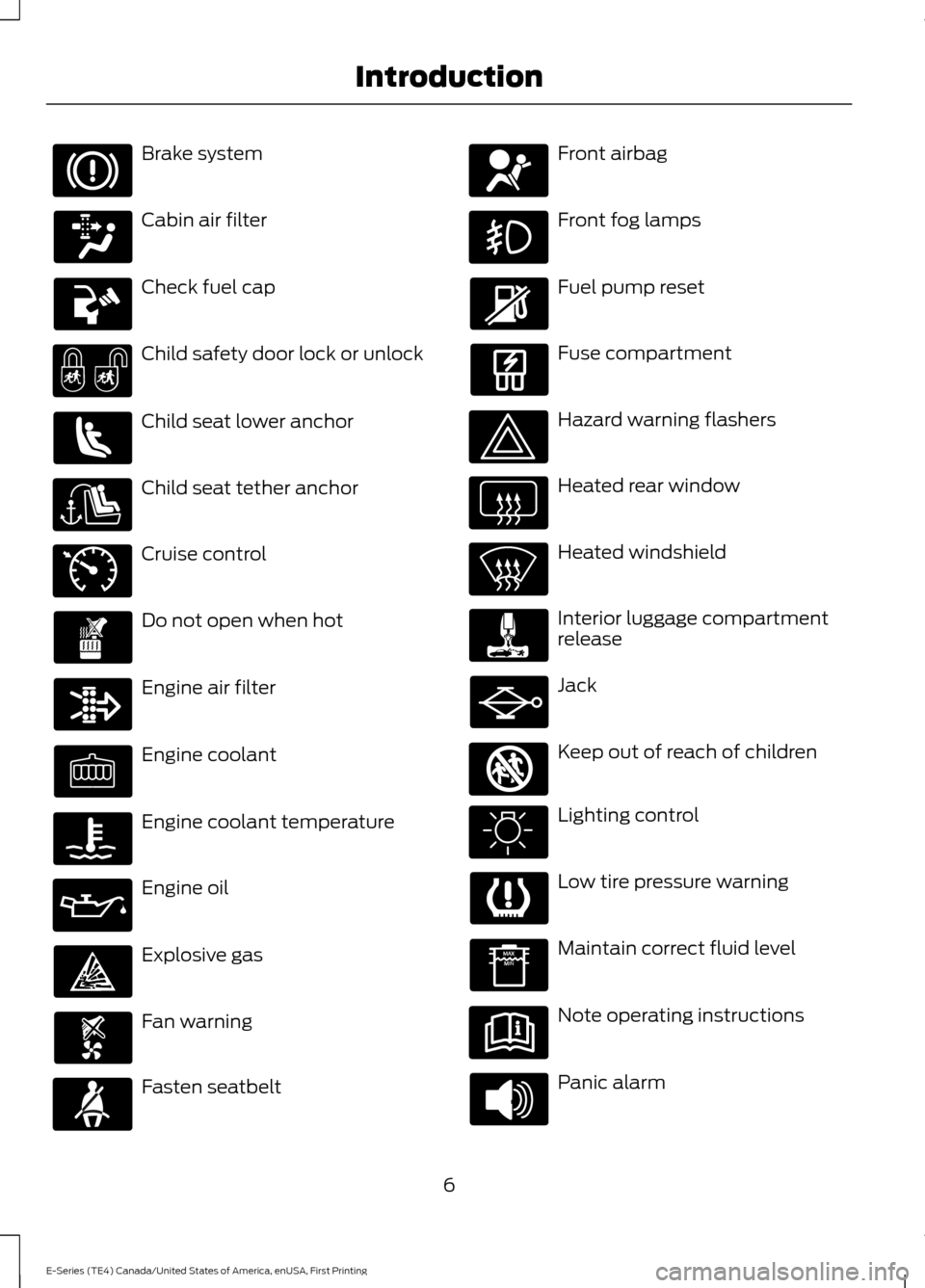
Brake system
Cabin air filter
Check fuel cap
Child safety door lock or unlock
Child seat lower anchor
Child seat tether anchor
Cruise control
Do not open when hot
Engine air filter
Engine coolant
Engine coolant temperature
Engine oil
Explosive gas
Fan warning
Fasten seatbelt Front airbag
Front fog lamps
Fuel pump reset
Fuse compartment
Hazard warning flashers
Heated rear window
Heated windshield
Interior luggage compartment
release
Jack
Keep out of reach of children
Lighting control
Low tire pressure warning
Maintain correct fluid level
Note operating instructions
Panic alarm
6
E-Series (TE4) Canada/United States of America, enUSA, First Printing Introduction E71340 E161353
Page 19 of 318
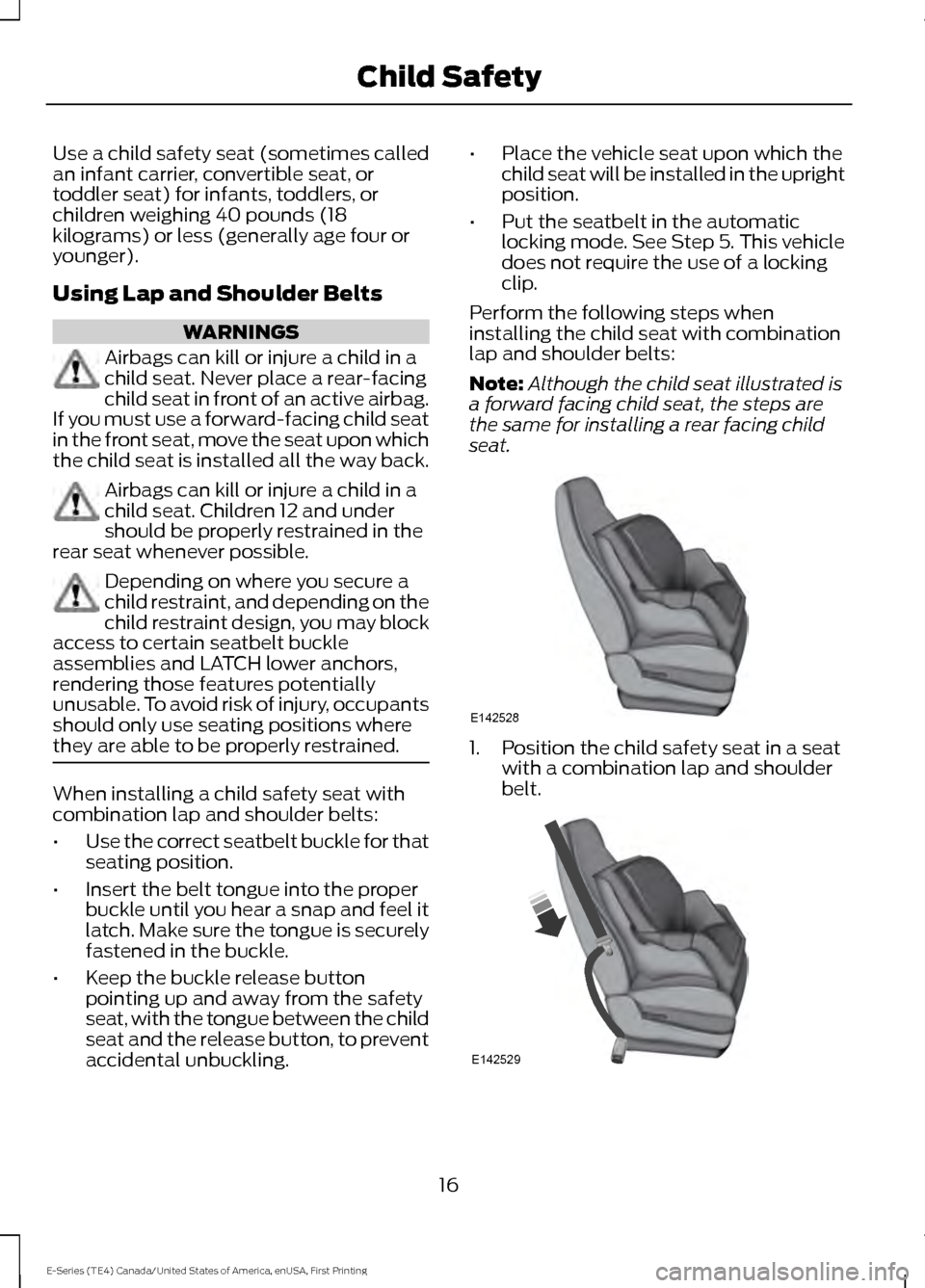
Use a child safety seat (sometimes called
an infant carrier, convertible seat, or
toddler seat) for infants, toddlers, or
children weighing 40 pounds (18
kilograms) or less (generally age four or
younger).
Using Lap and Shoulder Belts
WARNINGS
Airbags can kill or injure a child in a
child seat. Never place a rear-facing
child seat in front of an active airbag.
If you must use a forward-facing child seat
in the front seat, move the seat upon which
the child seat is installed all the way back. Airbags can kill or injure a child in a
child seat. Children 12 and under
should be properly restrained in the
rear seat whenever possible. Depending on where you secure a
child restraint, and depending on the
child restraint design, you may block
access to certain seatbelt buckle
assemblies and LATCH lower anchors,
rendering those features potentially
unusable. To avoid risk of injury, occupants
should only use seating positions where
they are able to be properly restrained. When installing a child safety seat with
combination lap and shoulder belts:
•
Use the correct seatbelt buckle for that
seating position.
• Insert the belt tongue into the proper
buckle until you hear a snap and feel it
latch. Make sure the tongue is securely
fastened in the buckle.
• Keep the buckle release button
pointing up and away from the safety
seat, with the tongue between the child
seat and the release button, to prevent
accidental unbuckling. •
Place the vehicle seat upon which the
child seat will be installed in the upright
position.
• Put the seatbelt in the automatic
locking mode. See Step 5. This vehicle
does not require the use of a locking
clip.
Perform the following steps when
installing the child seat with combination
lap and shoulder belts:
Note: Although the child seat illustrated is
a forward facing child seat, the steps are
the same for installing a rear facing child
seat. 1. Position the child safety seat in a seat
with a combination lap and shoulder
belt. 16
E-Series (TE4) Canada/United States of America, enUSA, First Printing Child SafetyE142528 E142529
Page 20 of 318
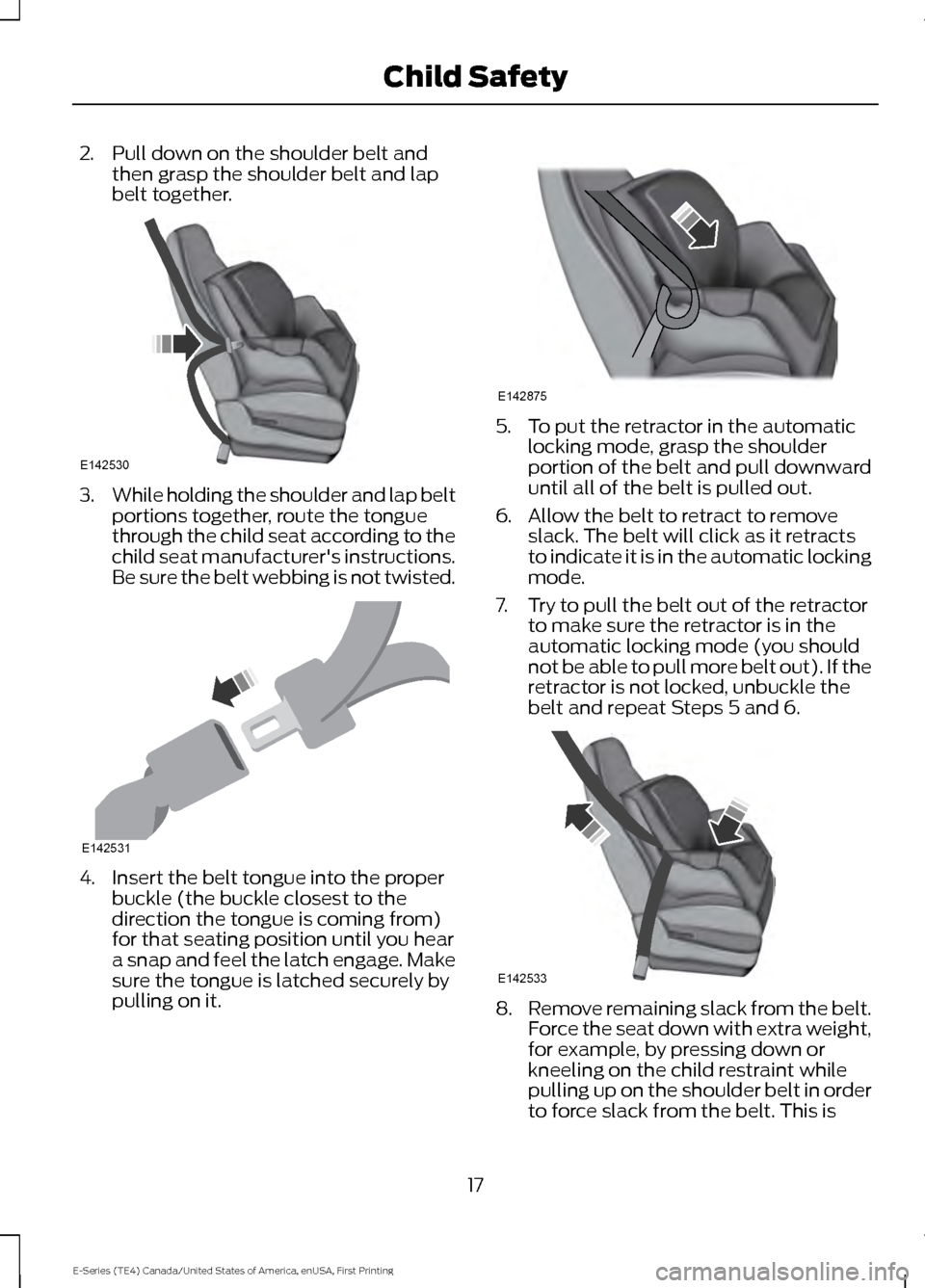
2. Pull down on the shoulder belt and
then grasp the shoulder belt and lap
belt together. 3.
While holding the shoulder and lap belt
portions together, route the tongue
through the child seat according to the
child seat manufacturer's instructions.
Be sure the belt webbing is not twisted. 4. Insert the belt tongue into the proper
buckle (the buckle closest to the
direction the tongue is coming from)
for that seating position until you hear
a snap and feel the latch engage. Make
sure the tongue is latched securely by
pulling on it. 5. To put the retractor in the automatic
locking mode, grasp the shoulder
portion of the belt and pull downward
until all of the belt is pulled out.
6. Allow the belt to retract to remove slack. The belt will click as it retracts
to indicate it is in the automatic locking
mode.
7. Try to pull the belt out of the retractor to make sure the retractor is in the
automatic locking mode (you should
not be able to pull more belt out). If the
retractor is not locked, unbuckle the
belt and repeat Steps 5 and 6. 8.
Remove remaining slack from the belt.
Force the seat down with extra weight,
for example, by pressing down or
kneeling on the child restraint while
pulling up on the shoulder belt in order
to force slack from the belt. This is
17
E-Series (TE4) Canada/United States of America, enUSA, First Printing Child SafetyE142530 E142531 E142875 E142533
Page 26 of 318
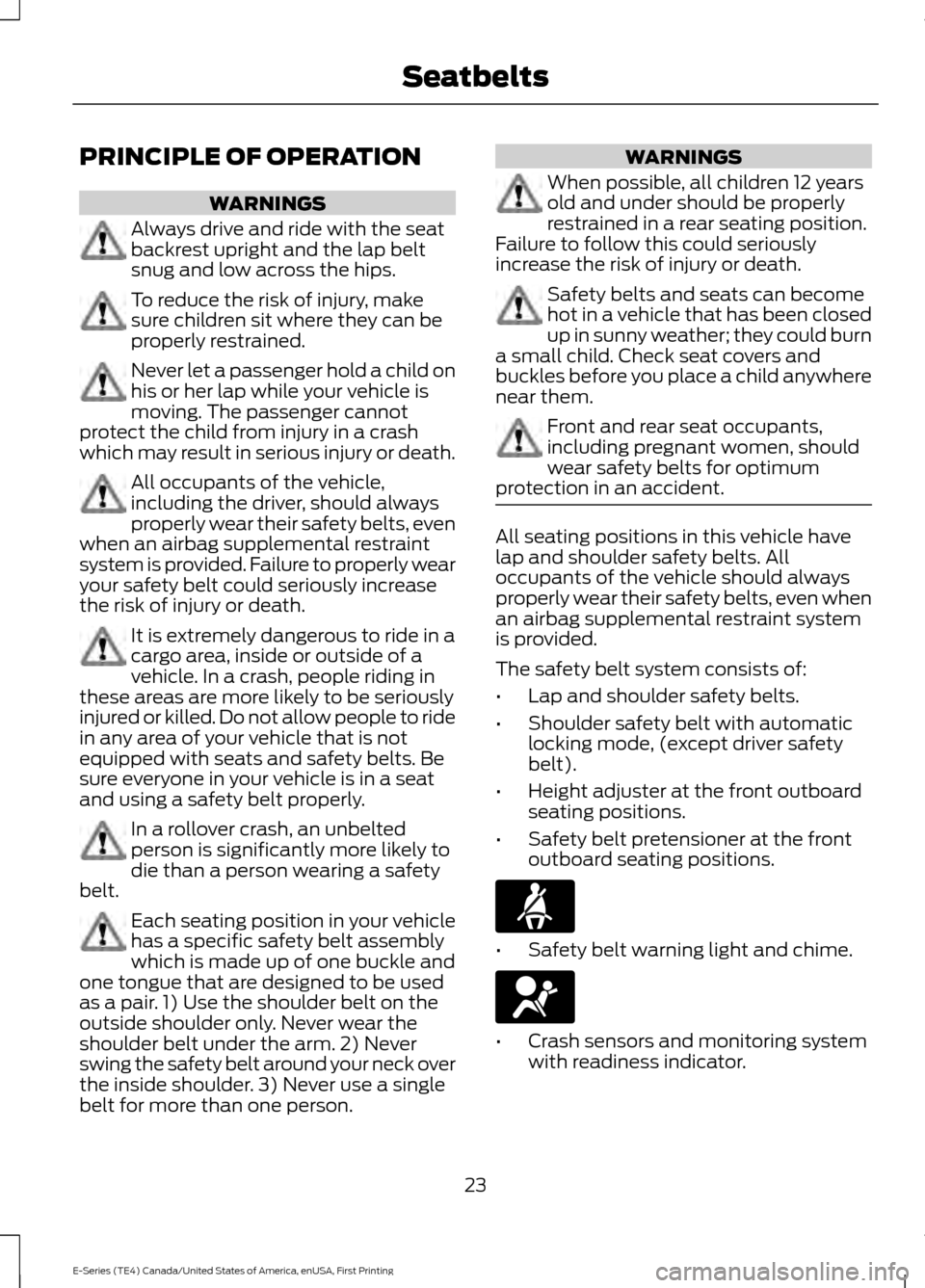
PRINCIPLE OF OPERATION
WARNINGS
Always drive and ride with the seat
backrest upright and the lap belt
snug and low across the hips.
To reduce the risk of injury, make
sure children sit where they can be
properly restrained.
Never let a passenger hold a child on
his or her lap while your vehicle is
moving. The passenger cannot
protect the child from injury in a crash
which may result in serious injury or death. All occupants of the vehicle,
including the driver, should always
properly wear their safety belts, even
when an airbag supplemental restraint
system is provided. Failure to properly wear
your safety belt could seriously increase
the risk of injury or death. It is extremely dangerous to ride in a
cargo area, inside or outside of a
vehicle. In a crash, people riding in
these areas are more likely to be seriously
injured or killed. Do not allow people to ride
in any area of your vehicle that is not
equipped with seats and safety belts. Be
sure everyone in your vehicle is in a seat
and using a safety belt properly. In a rollover crash, an unbelted
person is significantly more likely to
die than a person wearing a safety
belt. Each seating position in your vehicle
has a specific safety belt assembly
which is made up of one buckle and
one tongue that are designed to be used
as a pair. 1) Use the shoulder belt on the
outside shoulder only. Never wear the
shoulder belt under the arm. 2) Never
swing the safety belt around your neck over
the inside shoulder. 3) Never use a single
belt for more than one person. WARNINGS
When possible, all children 12 years
old and under should be properly
restrained in a rear seating position.
Failure to follow this could seriously
increase the risk of injury or death. Safety belts and seats can become
hot in a vehicle that has been closed
up in sunny weather; they could burn
a small child. Check seat covers and
buckles before you place a child anywhere
near them. Front and rear seat occupants,
including pregnant women, should
wear safety belts for optimum
protection in an accident. All seating positions in this vehicle have
lap and shoulder safety belts. All
occupants of the vehicle should always
properly wear their safety belts, even when
an airbag supplemental restraint system
is provided.
The safety belt system consists of:
•
Lap and shoulder safety belts.
• Shoulder safety belt with automatic
locking mode, (except driver safety
belt).
• Height adjuster at the front outboard
seating positions.
• Safety belt pretensioner at the front
outboard seating positions. •
Safety belt warning light and chime. •
Crash sensors and monitoring system
with readiness indicator.
23
E-Series (TE4) Canada/United States of America, enUSA, First Printing Seatbelts
Page 28 of 318
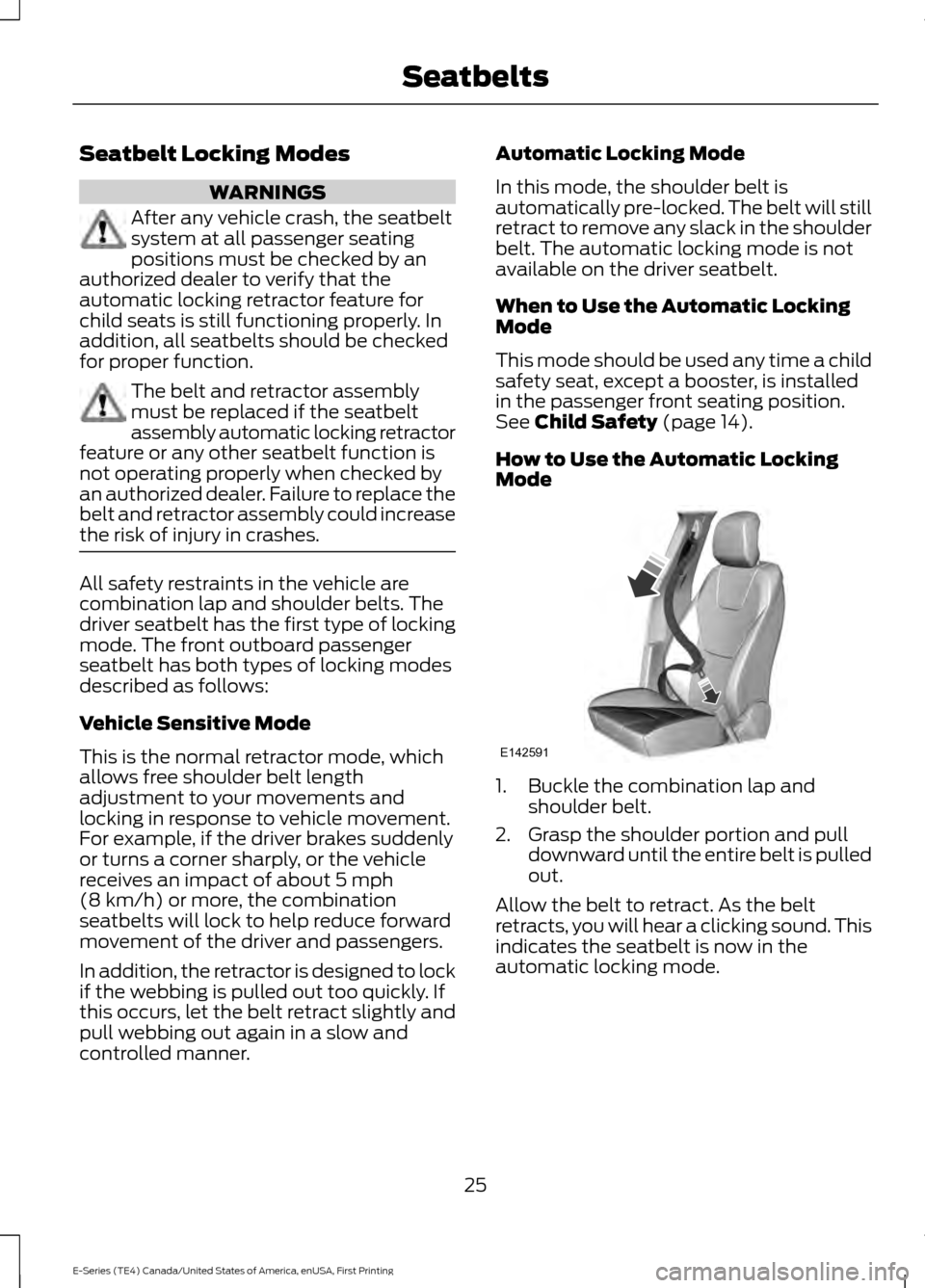
Seatbelt Locking Modes
WARNINGS
After any vehicle crash, the seatbelt
system at all passenger seating
positions must be checked by an
authorized dealer to verify that the
automatic locking retractor feature for
child seats is still functioning properly. In
addition, all seatbelts should be checked
for proper function. The belt and retractor assembly
must be replaced if the seatbelt
assembly automatic locking retractor
feature or any other seatbelt function is
not operating properly when checked by
an authorized dealer. Failure to replace the
belt and retractor assembly could increase
the risk of injury in crashes. All safety restraints in the vehicle are
combination lap and shoulder belts. The
driver seatbelt has the first type of locking
mode. The front outboard passenger
seatbelt has both types of locking modes
described as follows:
Vehicle Sensitive Mode
This is the normal retractor mode, which
allows free shoulder belt length
adjustment to your movements and
locking in response to vehicle movement.
For example, if the driver brakes suddenly
or turns a corner sharply, or the vehicle
receives an impact of about 5 mph
(8 km/h) or more, the combination
seatbelts will lock to help reduce forward
movement of the driver and passengers.
In addition, the retractor is designed to lock
if the webbing is pulled out too quickly. If
this occurs, let the belt retract slightly and
pull webbing out again in a slow and
controlled manner. Automatic Locking Mode
In this mode, the shoulder belt is
automatically pre-locked. The belt will still
retract to remove any slack in the shoulder
belt. The automatic locking mode is not
available on the driver seatbelt.
When to Use the Automatic Locking
Mode
This mode should be used any time a child
safety seat, except a booster, is installed
in the passenger front seating position.
See
Child Safety (page 14).
How to Use the Automatic Locking
Mode 1. Buckle the combination lap and
shoulder belt.
2. Grasp the shoulder portion and pull downward until the entire belt is pulled
out.
Allow the belt to retract. As the belt
retracts, you will hear a clicking sound. This
indicates the seatbelt is now in the
automatic locking mode.
25
E-Series (TE4) Canada/United States of America, enUSA, First Printing SeatbeltsE142591
Page 50 of 318
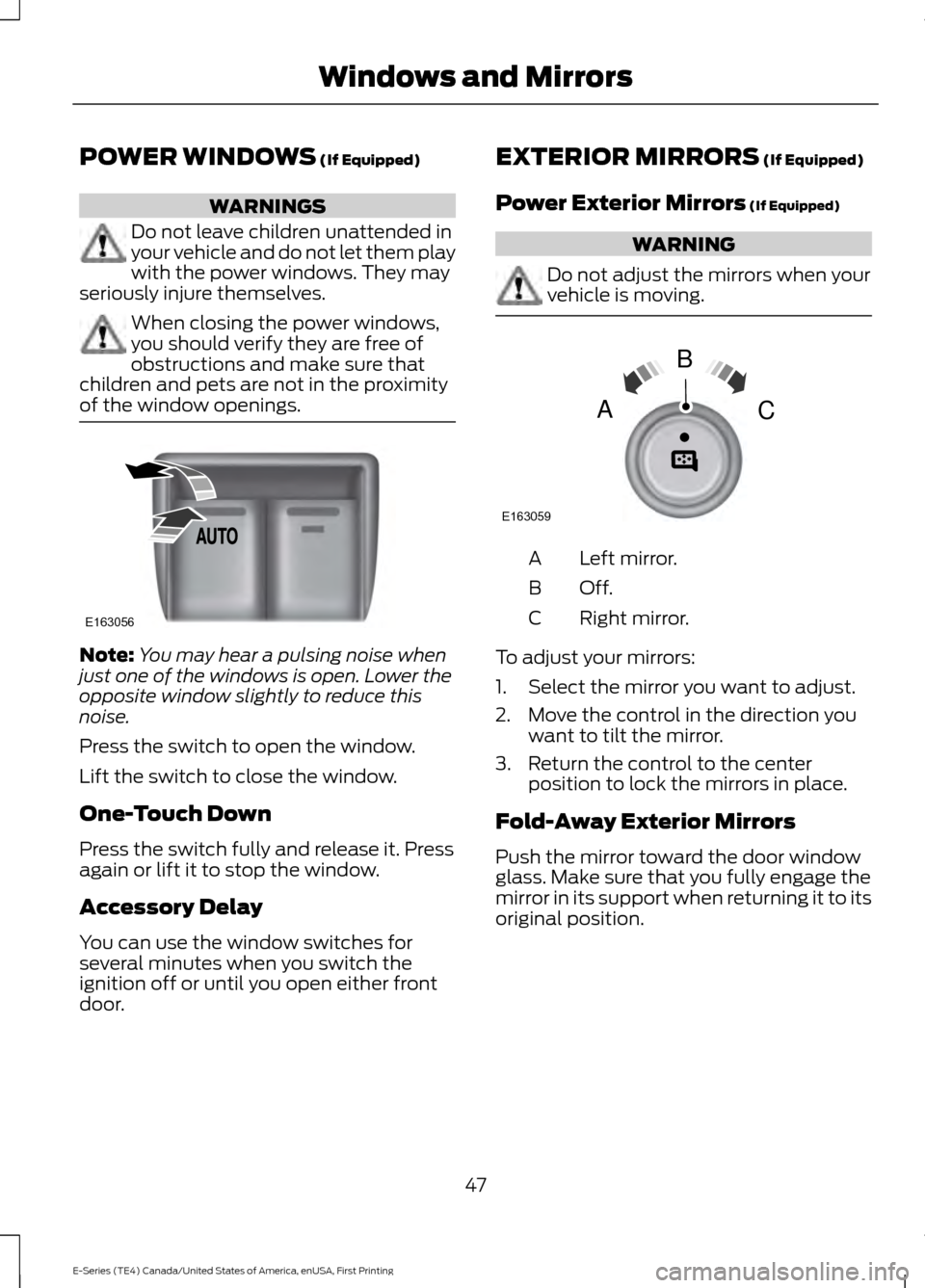
POWER WINDOWS (If Equipped)
WARNINGS
Do not leave children unattended in
your vehicle and do not let them play
with the power windows. They may
seriously injure themselves. When closing the power windows,
you should verify they are free of
obstructions and make sure that
children and pets are not in the proximity
of the window openings. Note:
You may hear a pulsing noise when
just one of the windows is open. Lower the
opposite window slightly to reduce this
noise.
Press the switch to open the window.
Lift the switch to close the window.
One-Touch Down
Press the switch fully and release it. Press
again or lift it to stop the window.
Accessory Delay
You can use the window switches for
several minutes when you switch the
ignition off or until you open either front
door. EXTERIOR MIRRORS (If Equipped)
Power Exterior Mirrors
(If Equipped) WARNING
Do not adjust the mirrors when your
vehicle is moving.
Left mirror.
A
Off.B
Right mirror.
C
To adjust your mirrors:
1. Select the mirror you want to adjust.
2. Move the control in the direction you want to tilt the mirror.
3. Return the control to the center position to lock the mirrors in place.
Fold-Away Exterior Mirrors
Push the mirror toward the door window
glass. Make sure that you fully engage the
mirror in its support when returning it to its
original position.
47
E-Series (TE4) Canada/United States of America, enUSA, First Printing Windows and MirrorsE163056 E163059
B
AC
Page 81 of 318
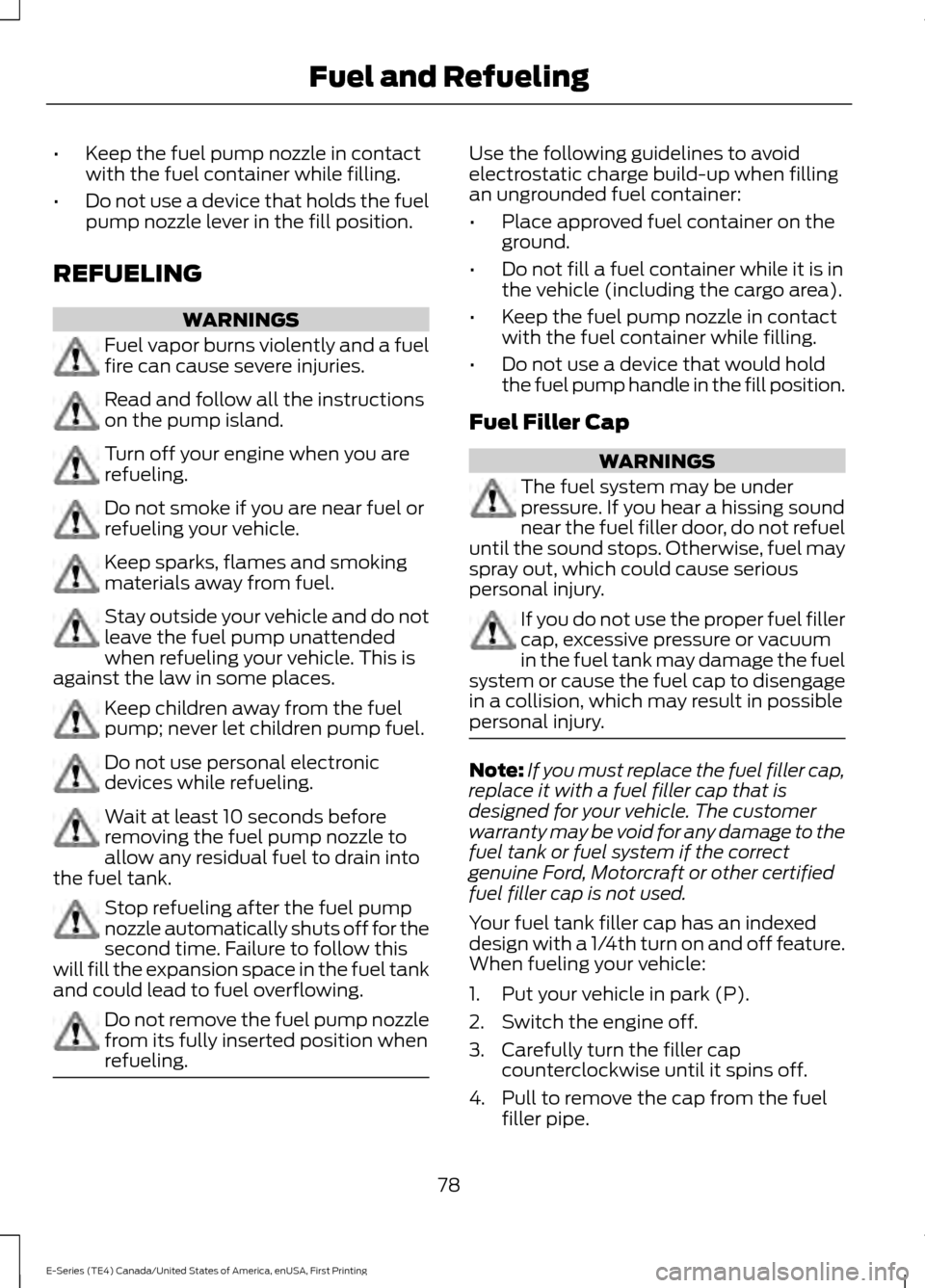
•
Keep the fuel pump nozzle in contact
with the fuel container while filling.
• Do not use a device that holds the fuel
pump nozzle lever in the fill position.
REFUELING WARNINGS
Fuel vapor burns violently and a fuel
fire can cause severe injuries.
Read and follow all the instructions
on the pump island.
Turn off your engine when you are
refueling.
Do not smoke if you are near fuel or
refueling your vehicle.
Keep sparks, flames and smoking
materials away from fuel.
Stay outside your vehicle and do not
leave the fuel pump unattended
when refueling your vehicle. This is
against the law in some places. Keep children away from the fuel
pump; never let children pump fuel.
Do not use personal electronic
devices while refueling.
Wait at least 10 seconds before
removing the fuel pump nozzle to
allow any residual fuel to drain into
the fuel tank. Stop refueling after the fuel pump
nozzle automatically shuts off for the
second time. Failure to follow this
will fill the expansion space in the fuel tank
and could lead to fuel overflowing. Do not remove the fuel pump nozzle
from its fully inserted position when
refueling. Use the following guidelines to avoid
electrostatic charge build-up when filling
an ungrounded fuel container:
•
Place approved fuel container on the
ground.
• Do not fill a fuel container while it is in
the vehicle (including the cargo area).
• Keep the fuel pump nozzle in contact
with the fuel container while filling.
• Do not use a device that would hold
the fuel pump handle in the fill position.
Fuel Filler Cap WARNINGS
The fuel system may be under
pressure. If you hear a hissing sound
near the fuel filler door, do not refuel
until the sound stops. Otherwise, fuel may
spray out, which could cause serious
personal injury. If you do not use the proper fuel filler
cap, excessive pressure or vacuum
in the fuel tank may damage the fuel
system or cause the fuel cap to disengage
in a collision, which may result in possible
personal injury. Note:
If you must replace the fuel filler cap,
replace it with a fuel filler cap that is
designed for your vehicle. The customer
warranty may be void for any damage to the
fuel tank or fuel system if the correct
genuine Ford, Motorcraft or other certified
fuel filler cap is not used.
Your fuel tank filler cap has an indexed
design with a 1/4th turn on and off feature.
When fueling your vehicle:
1. Put your vehicle in park (P).
2. Switch the engine off.
3. Carefully turn the filler cap counterclockwise until it spins off.
4. Pull to remove the cap from the fuel filler pipe.
78
E-Series (TE4) Canada/United States of America, enUSA, First Printing Fuel and Refueling
Page 313 of 318
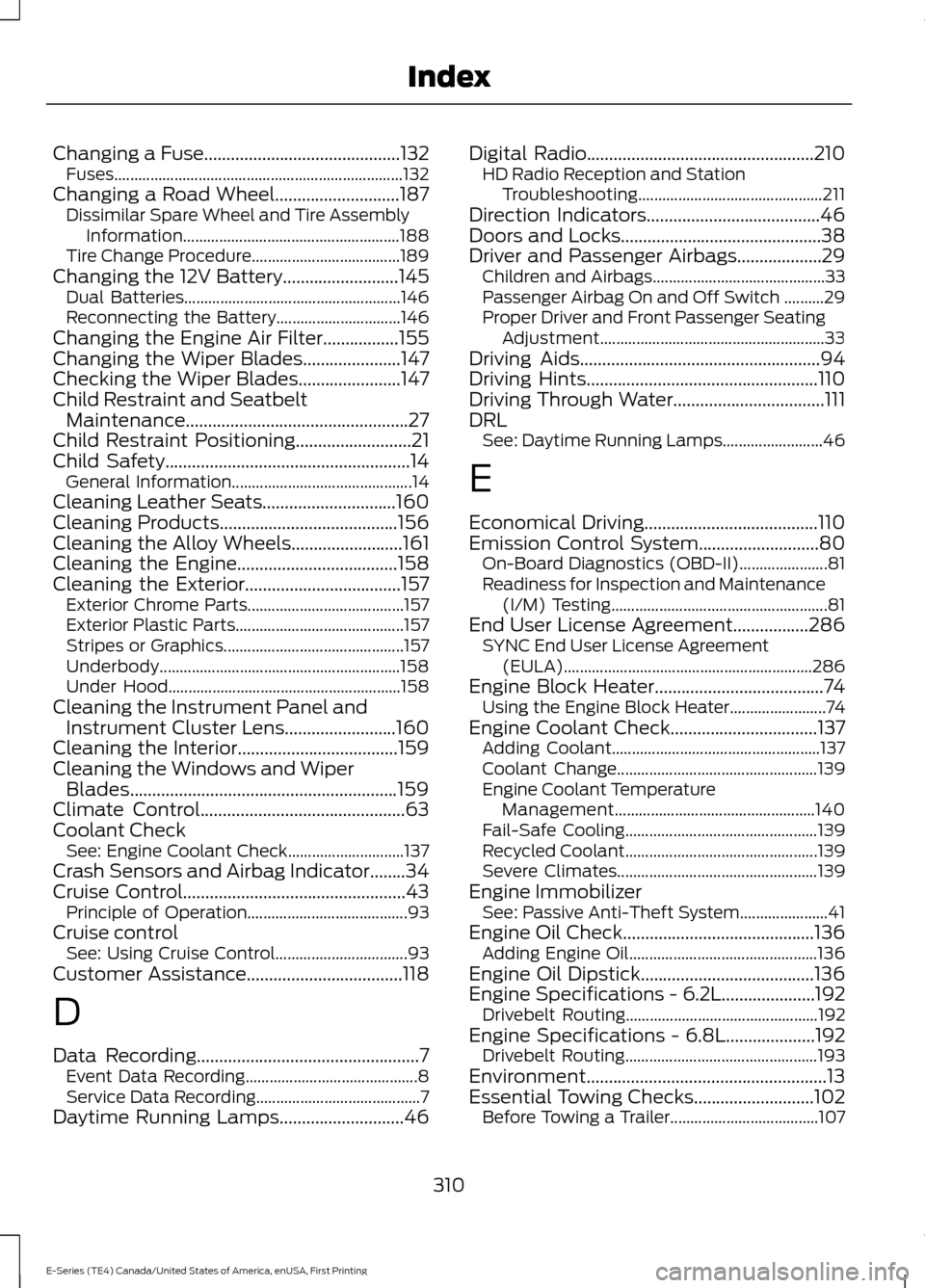
Changing a Fuse............................................132
Fuses........................................................................\
132
Changing a Road Wheel............................187 Dissimilar Spare Wheel and Tire Assembly
Information...................................................... 188
Tire Change Procedure..................................... 189
Changing the 12V Battery
..........................145
Dual Batteries...................................................... 146
Reconnecting the Battery............................... 146
Changing the Engine Air Filter.................155
Changing the Wiper Blades
......................147
Checking the Wiper Blades.......................147
Child Restraint and Seatbelt Maintenance..................................................27
Child Restraint Positioning
..........................21
Child Safety.......................................................14 General Information............................................. 14
Cleaning Leather Seats..............................160
Cleaning Products
........................................156
Cleaning the Alloy Wheels.........................161
Cleaning the Engine....................................158
Cleaning the Exterior...................................157 Exterior Chrome Parts....................................... 157
Exterior Plastic Parts.......................................... 157
Stripes or Graphics............................................. 157
Underbody............................................................ 158
Under Hood.......................................................... 158
Cleaning the Instrument Panel and Instrument Cluster Lens.........................160
Cleaning the Interior....................................159
Cleaning the Windows and Wiper Blades
............................................................159
Climate Control..............................................63
Coolant Check See: Engine Coolant Check............................. 137
Crash Sensors and Airbag Indicator........34
Cruise Control
..................................................43
Principle of Operation........................................ 93
Cruise control See: Using Cruise Control................................. 93
Customer Assistance
...................................118
D
Data Recording
..................................................7
Event Data Recording........................................... 8
Service Data Recording......................................... 7
Daytime Running Lamps
............................46 Digital Radio
...................................................210
HD Radio Reception and Station
Troubleshooting.............................................. 211
Direction Indicators
.......................................46
Doors and Locks.............................................38
Driver and Passenger Airbags...................29 Children and Airbags........................................... 33
Passenger Airbag On and Off Switch ..........29
Proper Driver and Front Passenger Seating Adjustment........................................................ 33
Driving Aids
......................................................94
Driving Hints....................................................110
Driving Through Water..................................111
DRL See: Daytime Running Lamps......................... 46
E
Economical Driving.......................................110
Emission Control System...........................80 On-Board Diagnostics (OBD-II)...................... 81
Readiness for Inspection and Maintenance (I/M) Testing...................................................... 81
End User License Agreement.................286 SYNC End User License Agreement
(EULA).............................................................. 286
Engine Block Heater......................................74 Using the Engine Block Heater........................ 74
Engine Coolant Check.................................137 Adding Coolant.................................................... 137
Coolant Change.................................................. 139
Engine Coolant Temperature Management
.................................................. 140
Fail-Safe Cooling................................................ 139
Recycled Coolant................................................ 139
Severe Climates.................................................. 139
Engine Immobilizer See: Passive Anti-Theft System...................... 41
Engine Oil Check
...........................................136
Adding Engine Oil............................................... 136
Engine Oil Dipstick.......................................136
Engine Specifications - 6.2L.....................192 Drivebelt Routing................................................ 192
Engine Specifications - 6.8L
....................192
Drivebelt Routing................................................ 193
Environment......................................................13
Essential Towing Checks...........................102 Before Towing a Trailer..................................... 107
310
E-Series (TE4) Canada/United States of America, enUSA, First Printing Index
Page 315 of 318

I
Ignition Switch.................................................72
In California (U.S. Only)..............................119
Information Displays.....................................55 General Information............................................ 55
Information Messages
.................................60
Brake System........................................................ 60
Fuel........................................................................\
... 60
Maintenance.......................................................... 60
Tire........................................................................\
...... 61
Traction Control..................................................... 61
Trailer........................................................................\
62
Transmission.......................................................... 62
Installing Child Restraints............................15 Child Seats............................................................... 15
Using Lap and Shoulder Belts.......................... 16
Using Tether Straps.............................................. 18
Instrument Cluster........................................49
Instrument Lighting Dimmer.....................46
Interior Mirror...................................................48 Auto-Dimming Mirror......................................... 48
Introduction........................................................5
J
Jump Starting the Vehicle..........................115 Connecting the Jumper Cables...................... 115
Jump Starting........................................................ 116
Preparing Your Vehicle....................................... 115
Removing the Jumper Cables......................... 116
K
Keys and Remote Controls.........................35
L
Lighting Control
..............................................45
Headlamp Flasher............................................... 46
High Beams............................................................ 45
Lighting..............................................................45 General Information............................................ 45
Load Carrying
..................................................95
Load Limit.........................................................95
Special Loading Instructions for Owners of
Pick-up Trucks and Utility-type
Vehicles.............................................................. 99Vehicle Loading - with and without a
Trailer................................................................... 95
Locking and Unlocking.................................38 Autolock Feature.................................................. 39
Autounlock Feature............................................. 39
Enabling or Disabling Autolock and Autounlock........................................................ 39
Illuminated Entry.................................................. 39
Power Door Locks................................................ 38
Remote Control.................................................... 38
Lug Nuts See: Changing a Road Wheel......................... 187
M
Maintenance..................................................134 General Information.......................................... 134
Manual Climate Control..............................63 Heater Only System............................................ 63
Manual Climate Control.................................... 64
Manual Seats
..................................................68
Manual Lumbar ................................................... 69
Moving the Seat Backward and Forward.............................................................. 68
Recline Adjustment............................................ 68
Message Center See: Information Displays................................. 55
Mirrors See: Windows and Mirrors................................ 47
Mobile Communications Equipment
.......12
Motorcraft Parts - 6.2L...............................193
Motorcraft Parts - 6.8L..............................194
N
Normal Scheduled Maintenance
............271
O
Oil Change Indicator Reset.......................136 Resetting the Oil Life Monitoring
System............................................................... 136
Oil Check See: Engine Oil Check....................................... 136
Opening and Closing the Hood
...............134
Ordering Additional Owner's Literature.......................................................122
Obtaining a French Owner ’s Manual...........123
312
E-Series (TE4) Canada/United States of America, enUSA, First Printing Index